Small overlap front
The small overlap front evaluation consists of a driver-side and a passenger-side component. If the results of the two evaluations differ, then the combined small overlap rating is equal to the lower rating.
Driver-side
- Rating applies to 2019-25 models
Tested vehicle: 2016 Honda Pilot EX 4-door 4wd
The Honda Pilot was redesigned for the 2016 model year, and the Honda Passport was introduced in the 2019 model year. The Passport is derived from the Pilot, but it has a slightly shorter overall length and only two rows of seats instead of three. Ratings apply to both the Pilot and Passport.
| Evaluation criteria | Rating |
|---|---|
| Overall driver-side evaluation | |
| Structure and safety cage | |
| Driver injury measures | |
| Head/neck | |
| Chest | |
| Hip/thigh | |
| Lower leg/foot | |
| Driver restraints and dummy kinematics | |
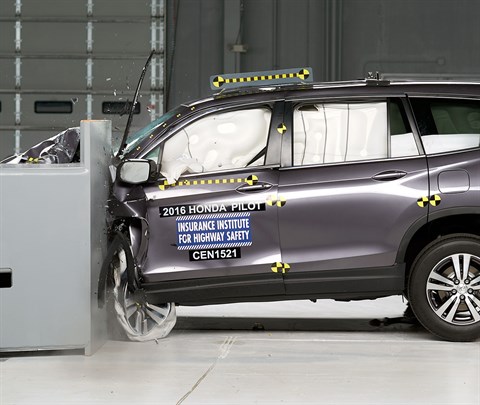
Action shot taken during the driver-side small overlap frontal crash test.

The dummy's position in relation to the door frame, steering wheel, and instrument panel after the crash test indicates that the driver's survival space was maintained well.
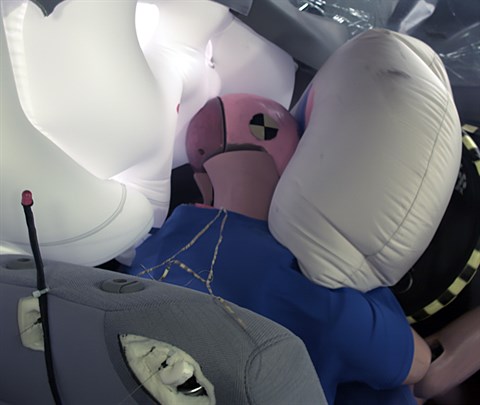
The frontal and side curtain airbags worked well together to keep the head from coming close to any stiff structure or outside objects that could cause injury.

The driver's space was maintained well, and risk of injuries to the dummy's legs and feet was low.
Passenger-side
- Rating applies to 2019-25 models
Tested vehicle: 2018 Honda Pilot EX 4-door 4wd
The Honda Pilot was redesigned for the 2016 model year, and the Honda Passport was introduced in the 2019 model year. The Passport is derived from the Pilot, but it has a slightly shorter overall length and only two rows of seats instead of three. Ratings apply to both the Pilot and Passport.
| Evaluation criteria | Rating |
|---|---|
| Overall passenger-side evaluation | |
| Structure and safety cage | |
| Passenger injury measures | |
| Head/neck | |
| Chest | |
| Hip/thigh | |
| Lower leg/foot | |
|
Passenger restraints and dummy kinematics
The dummy’s head barely contacted the frontal airbag before sliding off the right side, allowing the head to move far enough forward to hit the dashboard. The side curtain airbag deployed and has sufficient forward coverage to protect the head from contact with side structure and outside objects. The side torso airbag also deployed. | |
| Driver injury measures | |
| Head/neck | |
| Chest | |
| Hip/thigh | |
| Lower leg/foot | |
| Driver restraints and dummy kinematics | |

Action shot taken during the passenger-side small overlap frontal crash test.
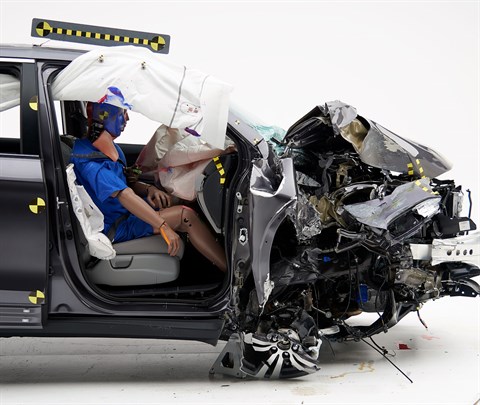
The dummy's position in relation to the door frame and dashboard after the crash test indicates that the passenger’s survival space was maintained well.

The dummy’s head slid off the right side of the frontal airbag and moved far enough forward to hit the dashboard hard.
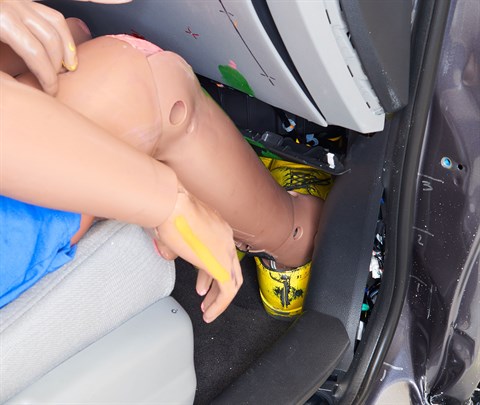
Forces on the right lower leg were high enough to indicate a moderate risk of injury.
Moderate overlap front: original test
Rating applies to 2019-25 models
Tested vehicle: 2016 Honda Pilot Touring 4-door 4wd
The Honda Pilot was redesigned for the 2016 model year. Moderate overlap frontal ratings are assigned by the Institute based on a test conducted by Honda. The ratings also apply to the Honda Passport, introduced in the 2019 model year. The Passport is derived from the Pilot, but it has a slightly shorter overall length and only two rows of seats instead of three.
| Evaluation criteria | Rating |
|---|---|
| Overall evaluation | |
| Structure and safety cage | |
| Driver injury measures | |
| Head/neck | |
| Chest | |
| Leg/foot, left | |
| Leg/foot, right | |
| Driver restraints and dummy kinematics | |
Side: original test
Rating applies to 2019-25 models
Tested vehicle: 2016 Honda Pilot Touring 4-door 4wd
The Honda Pilot was redesigned for the 2016 model year. Side ratings are assigned by the Institute based on a test conducted by Honda. The ratings also apply to the Honda Passport, introduced in the 2019 model year. The Passport is derived from the Pilot, but it has a slightly shorter overall length and only two rows of seats instead of three.
| Evaluation criteria | Rating |
|---|---|
| Overall evaluation | |
| Structure and safety cage | |
| Driver injury measures | |
| Head/neck | |
| Torso | |
| Pelvis/leg | |
| Driver head protection | |
| Rear passenger injury measures | |
| Head/neck | |
| Torso | |
| Pelvis/leg | |
| Rear passenger head protection | |
Side: updated test
Rating applies to 2019-25 models
Tested vehicle: 2022 Honda Pilot EX-L 4-door 4wd
The Honda Pilot was redesigned for the 2016 model year. The ratings also apply to the Honda Passport, introduced in the 2019 model year. The Passport is derived from the Pilot, but it has a slightly shorter overall length and only two rows of seats instead of three.
| Evaluation criteria | Rating |
|---|---|
| Overall evaluation | |
| Structure and safety cage | |
| Driver injury measures | |
| Head/neck | |
| Torso | |
| Pelvis | |
| Driver head protection | |
| Rear passenger injury measures | |
| Head/neck | |
| Torso | |
| Pelvis | |
| Rear passenger head protection | |
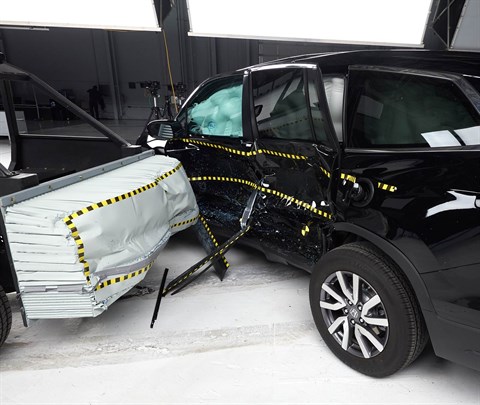
View of the vehicle just after the crash test.
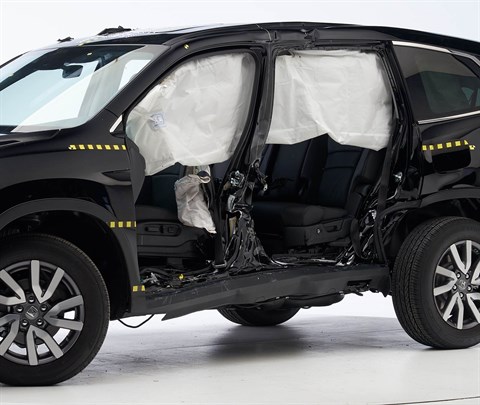
View of the vehicle after the crash with doors removed, showing the side airbags and damage to the occupant compartment.
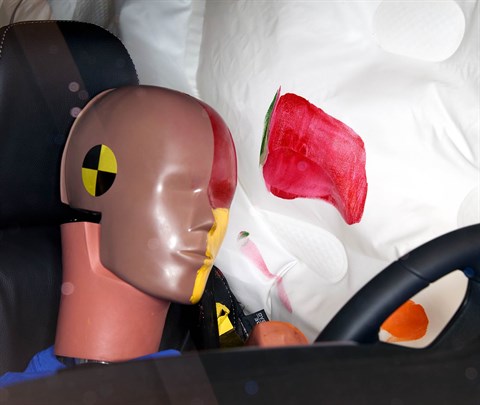
Smeared greasepaint shows where the driver dummy's head was protected from being hit by hard structures by the side airbags.

Smeared greasepaint shows where the rear passenger dummy’s head was protected by the side airbag.
Child seat anchors
Rating applies to 2019-25 models
| Evaluation criteria | Rating |
|---|---|
| Overall evaluation | |
| Vehicle trim | EX-L |
| Seat type | leather |
This vehicle has 3 rear seating positions with complete child seat attachment (LATCH) hardware.
| Evaluation criteria | Rating |
|---|---|
| Overall evaluation | |
| Vehicle trim | EX-L |
| Seat type | leather |
| Rating icon | Rating |
|---|---|
| G | Good |
| A | Acceptable |
| M | Marginal |
| P | Poor |
| Seating positions that rely on borrowed lower anchors or have only a tether anchor available are not rated. | |
thether anchor symbol | Tether anchor |
lower anchor symbol | Lower anchors |
| Lower anchor(s) can be borrowed from adjacent positions(s) | |
| No hardware available |
Details by seating position
| Position | Rating |
|---|---|
| 1 | |
| Tether anchor | |
| hard-to-find location | |
| no other hardware could be confused for anchor | |
| Lower anchors | |
| too deep in seat | |
| not too much force needed to attach | |
| easy to maneuver around anchors | |
| 2 | |
| Tether anchor | |
| hard-to-find location | |
| no other hardware could be confused for anchor | |
| Lower anchors | |
| too deep in seat | |
| not too much force needed to attach | |
| difficult to maneuver around anchors | |
| 3 | |
| Tether anchor | |
| hard-to-find location | |
| no other hardware could be confused for anchor | |
| Lower anchors | |
| too deep in seat | |
| not too much force needed to attach | |
| easy to maneuver around anchors |
